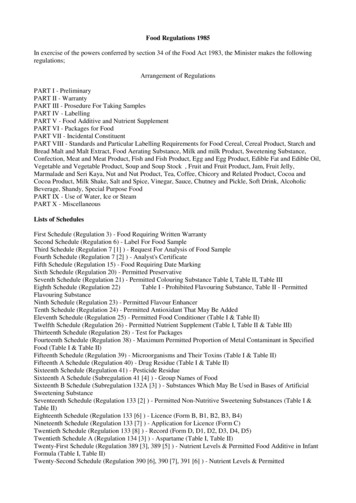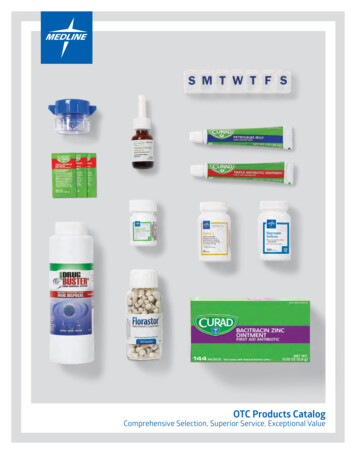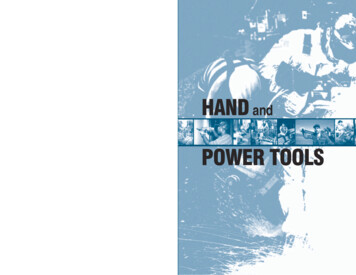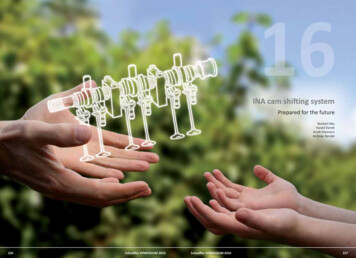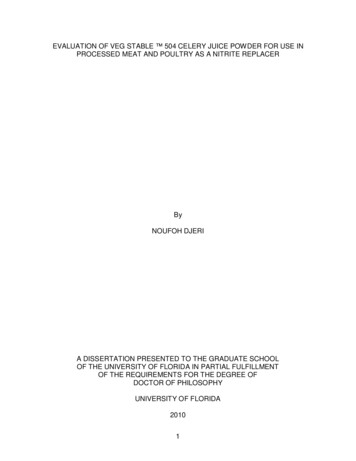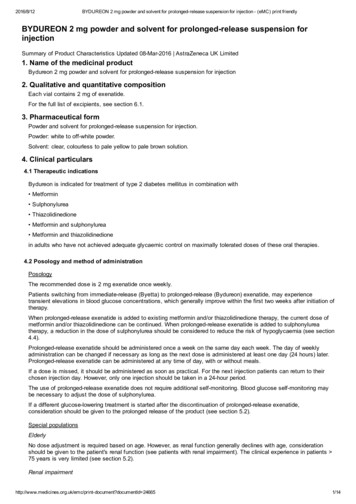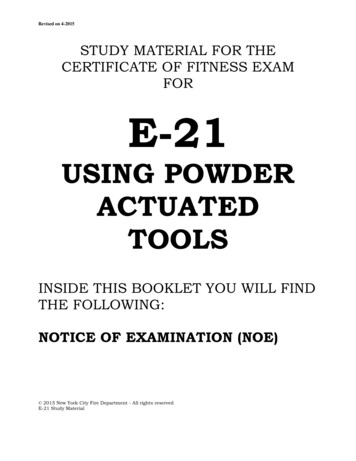
Transcription
Revised on 4-2015STUDY MATERIAL FOR THECERTIFICATE OF FITNESS EXAMFORE-21USING POWDERACTUATEDTOOLSINSIDE THIS BOOKLET YOU WILL FINDTHE FOLLOWING:NOTICE OF EXAMINATION (NOE) 2015 New York City Fire Department - All rights reservedE-21 Study Material
Table of ContentsNOTICE OF EXAMINATION . 3About the Study Material . 81. INTRODUCTION . 92. DEFINITIONS. 93. PERMITS AND INSURANCE . 104. TYPES AND CLASSES OF TOOLS . 11Indirect Contact. 115. POWER LOADS . 12Selecting a Power Load . 13Storage of Power Loads . 146. BASE MATERIALS . 15Masonry Materials . 15Steel . 16Fasteners . 17Center Punch Test Procedure. 177. FASTENING PROCEDURES. 18Fastening Into Masonry . 18Fastening Into Steel . 198. GENERAL SAFETY PRECAUTIONS . 20E-21 Certificate of Fitness holder (operator) . 20Care and Servicing of Tools . 21Use and Limitations of Tools . 21Power Loads . 22Disposal . 22Spent Cartridges . 22Unspent cartridges . 22SAFETY IN REVIEW. 239. FIRE SAFETY . 23Fire Extinguishers . 23Monthly Inspection-. 25Annual Inspection . 25Notifications: . 262
NOTICE OF EXAMINATIONTitle: Examination for Certificate of Fitness for Powder Actuated Tools (E-21)Date of Exam: Written exams are conducted Monday through Friday (except legalholidays) 8:00 AM to 2:30 PM.REQUIREMENTS FOR WRITTEN EXAMApplicants who need to take the exam must apply in person and bring thefollowing documents:1. Applicants must be at least 18 years of age.2. Applicants must have a reasonable understanding of the English language.3. Applicant must provide two forms of identifications; at least oneidentification must be government issued photo identification, such as aState-issued Driver’s License or Non Driver’s License or a passport.4. Applicants must present a letter of recommendation from his/heremployer. The letter must be on official letterhead, and must state theapplicant’s full name, experience and the address where the applicant willwork. If the applicants are self-employed or the principal of the company,they must submit a notarized letter attesting to their qualifications. Formore info:http://www.nyc.gov/html/fdny/html/c of f/cof requirements.shtml5. Applicants must present a completed application for certificate of fitness(A-20 Form). http://www.nyc.gov/html/fdny/pdf/a20.pdf6. Special requirements for E-21 exam:Applicants must present a letter on official letterhead or a certificate issuedby the manufacturer stating he/she has received and completed thetraining program covering operation, maintenance and recommendedpractices for the powder activated tools that will be used.APPLICATION FEES:The 25 application fee for the exam can be paid by one of the following methods: Cash Credit card (American Express, Discover, MasterCard, or Visa) Debit card (MasterCard or Visa) Personal or company check or money order (made payable to the NewYork City Fire Department)For fee waivers submit: (Only government employees who will use their C of F fortheir work- related responsibilities are eligible for fee waivers.)A letter requesting fee waiver on the Agency’s official letterhead stating applicantfull name, exam type and address of premises; AND Copy of identification cardissued by the agency.A convenience fee of 2.49% will be applied to all credit card payments.3
EXAM INFORMATIONThe E-21 exam will consist of 20 multiple-choice questions, administered on a“touch screen” computer monitor. It is a time-limit exam. A passing score of atleast 70% is required in order to secure a Certificate of Fitness. Call (718) 9991988 for additional information and forms.Please always check for the latest revised booklet at FDNY website before youtake the exam.http://www.nyc.gov/html/fdny/pdf/cof study material/e 21 st mat.pdfIf all the requirements are meet and pass the exam a certificate will beissued the same day. Applicant who fails the exam will receive a failurereport. To retake the exam applicants will need to submit a newapplication and payment.ALTERNATIVE ISSUANCE PROCEDURE (AIP)This certificate of fitness can be obtained by qualifying for an exemption from anexam on the basis of education and experience. Applicants who qualify for AIPmust apply online. For more detail information applicants must review the E-21AIP information.http://www.nyc.gov/html/fdny/pdf/cof study material/e 21 aip info.pdfRENEWAL REQUIREMENTSThis Certificate of Fitness must be renewed every THREE YEARS. The renewalfee is 15. FDNY also reserves the right to require the applicants to take a reexamination upon submission of renewal applications.You will receive a courtesy notice of renewal 90 days before the expiration date.However, it is your responsibility to renew your Certificate. It is very important torenew your C of F before it expires. Renewals submitted 90 days (up to one year)after the expiration date will incur a 25 penalty in addition to the renewal fee.Certificates expired over one year past expiration date will not be renewed. Newexams will be required.To change a mailing address:Submit a letter requesting the change of mailing address and a copy of your C ofF and a 5.00 fee.To change a work location,Submit a letter from your current employer (on company letterhead) confirmingthat you are an employee and stating your new work location with a copy of yourC of F and a 5.00 fee.4
To request a replacement certificate:Submit a driver’s license or passport, social security number and mailing addressand a 5.00 fee.The certificate can be renewed On-line, by Mail or in Person.Renewal onlineIf you are an individual, make sure you have your 12 digit Certificate of FitnessAccess ID. This can be found on your Renewal Notice. If you do not have yourRenewal Notice, your Access ID is your 8 digit Certificate of Fitness number andthe last four digits of your social security number. If you are submitting renewalson behalf of a company's employees, the company must be approved by FDNYand have an 8 digit Company Code. To request approval, emailpubrenew@fdny.nyc.gov.Renewal fee can be paid by one of the following methods: Credit card (American Express, Discover, MasterCard, or Visa) Debit card (MasterCard or Visa) E-checkA fee exempted applicants cannot renew online only by mail or in person.If all the requirements are met, the certificate of fitness will be mailed out within10 days.For online renewal go to: enewal by mailMail your Renewal Notice (if you did not receive a Renewal Notice, a copy of yourcertificate), along with your fee payment Personal or company check or moneyorder (made payable to the NYC Fire Department)For fee waivers submit: (Only government employees who will use their C of F fortheir work- related responsibilities are eligible for fee waivers.) A letter requesting fee waiver on the Agency’s official letterhead statingapplicant full name, exam type and address of premises; ANDCopy of identification card issued by the agency and if applicable,supporting documents to:NYC Fire Department (FDNY)Cashier's Unit9 MetroTech Center, 1st FloorBrooklyn, NY 112015
If all the requirements are met, the certificate of fitness will be mailed out withinfour to six weeks.Renewal in personSubmit your Renewal Notice (or if you did not receive a Renewal Notice, a copy ofyour certificate), along with your fee payment by one of the following methods: Cash Credit card (American Express, Discover, MasterCard, or Visa) Debit card (MasterCard or Visa) Personal or company check or money order (made payable to the NewYork City Fire Department)For fee waivers submit: (Only government employees who will use their C of F fortheir work- related responsibilities are eligible for fee waivers.) A letter requesting fee waiver on the Agency’s official letterhead statingapplicant full name, exam type and address of premises; ANDCopy of identification card issued by the agency and if applicable, yoursupporting documents to:NYC Fire Department (FDNY)Cashier's Unit9 MetroTech Center, 1st FloorBrooklyn, NY 11201If all the requirements are met, the certificate of fitness will be issued the sameday.A convenience fee of 2.49% will be applied to all credit card payments for originalor renewal certificates.6
EXAM SITE: FDNY Headquarters, 9 Metro Tech Center, Brooklyn, NY. Enterthrough the Flatbush Avenue entrance (between Myrtle Avenue and Tech Place).7
About the Study MaterialThis study material will help you prepare for the examination for the Certificateof Fitness for Using Powder (Ammunition) Activated Tools. The study materialincludes information taken from the New York City Fire Code Chapter 14 (1418)and 33 (3306) and the Fire Prevention Directives of the Bureau of FirePrevention, FDNY. The study material does not contain all of the information youneed to know in order to work with powder activated tools at your work location.It is your responsibility to learn whatever else you need to know to do your job.You must also become familiar with all applicable rules and regulations of theCity of New York, even if they are not covered in this material.All questions on the Certificate of Fitness examination are multiple choice, withfour alternative answers to each question. Only one answer is correct for eachquestion. If you do not answer a question or mark more than one alternativeyour answer will be scored as incorrect. A score of 70% correct is required on theexamination in order to qualify for the Certificate of Fitness. Read each questioncarefully before marking your answer. There is no penalty for guessing.Sample Questions1. Who was the first president of the United States?(A) George Washington.(B) Winston Churchill.(C) Abraham Lincoln.(D) Barack Obama.The correct answer is "A". You would mark "A" on your touch-screen terminal.2. What sports team plays at Madison Square Garden?(A) Yankees.(B) Nets(C) Cardinals.(D) Knicks.The correct answer is "D". You would mark "D" on your touch-screen terminal.8
1. INTRODUCTIONA powder (or ammunition) actuated fastening system is an acceptable method ofmaking instantaneous forced entry fastenings into various constructionmaterials. The tools are used to make fastenings to very hard materials such asconcrete or steel. Although this system is simple to use, there are precautionsand safeguards that must be observed. Powder-actuated tools shall only be usedand handled by a qualified operator and Certificate of Fitness holder. To become aqualified operator, additional training covering operation, maintenance andrecommended practices for each manufacturer's tool is necessary. A qualifiedoperator should also read and be familiar with any local and state regulationsapplicable to this system. Any powder actuated tools using ammunition musthave a label stating that is has been approved by the Board of Standards andAppeals.2. DEFINITIONSBASE MATERIAL. The base into which the fastener is driven (e.g. structuralsteel or bar joist).CERTIFICATE OF FITNESS. A written statement issued by the commissionercertifying that the person to whom it is issued has passed an examination as tohis or her qualifications or is otherwise deemed qualified to perform one or moreof the following duties, for which such certificate is required by this code or therules: supervise a facility; conduct or supervise an operation; supervise thestorage, handling and/or use of a material; or conduct or supervise emergencyplanning and preparedness activities.DAY BOX. Small locked metal box used to store ammunition in quantities usedfor a day’s work.DRIVE PIN. A special fastener designed to permanently attach one material toanother such as wood to concrete or steel.GANG BOX. Large locked metal box used to store ammunition in largequantities.GENERAL SUPERVISION. Except as otherwise provided in this code, supervisionby the holder of any department certificate who is responsible for performing theduties set forth in FC113.2 but need not be personally present on the premises atall times.113.2 Duties. In addition to any other responsibilities specified in thiscode or the rules, a certificate holder shall be responsible for:1. the safe storage and/or supervision of the material, operation or facility,and emergency preparedness, for which the certificate is required, in accordance9
with the Fire Code, the rules, and any other applicable laws, rules andregulations.2. notifying the department of any fire, explosion, reportable leak or otherrelease of hazardous material, or other emergency related to the duties of his orher certificate.3. keeping such certificate upon his or her person or otherwise readilyavailable on the premises for inspection by any representative of the department,at all times while conducting or supervising the material, operation, facility oremergency preparedness for which the certificate is required.FASTENING. The combination of fastener, fastened material and base material(after the fastener has been driven).INHABITED BUILDING. A building regularly occupied in whole or in part as ahabitation for human beings, or any house of worship, school building, railroadstation, store or other structure where people are accustomed to assemble.MAGAZINE STRIP. Collated cartridges in strips of 10 (or 40) offer greater safetybecause the plastic strip helps protest the cartridge cases from impacts andensures separation between the cartridges.PERMIT. A written statement issued by the commissioner authorizing themanufacture, storage, handling, use or transportation of a hazardous material,or other material, or to conduct an operation or to maintain a facility, for which apermit is required by the Fire Code.POWDER ACTUATED TOOL. A tool that utilizes expanding gases from a powderload to drive a fastener.SMALL ARMS AMMUNITION. A shotgun, rifle or pistol cartridge, and anycartridge for propellant-actuated devices, excluding ammunition containingbursting charges or incendiary, trace, spotting or pyrotechnic projectiles.THREADED STUD. A fastener comprised of a shank portion which is driven intothe base material and a threaded portion to which an object can be attached witha nut.3. PERMITS AND INSURANCEIn order to store, handle, and use power loads at construction sites andmercantile establishments it is necessary to obtain a permit from the FDNY.Permits are required to store or sell 200 or more shells of power actuatedmagazine strips or cartridges.To qualify for a permit the following requirements must be met:10
Any employee storing, handling and using power loads must hold avalid E-21 Certificate of FitnessContractor must submit a copy of their liability insurance in theminimum sum of 100,000A Site inspection by the FDNY Explosives Unit must take place todetermine feasibility.4. TYPES AND CLASSES OF TOOLSThe illustration below shows a commonly used tool for drive pin and threadedstud fastenings. Although there are many different models, in all cases afastener is forced rapidly down the barrel of the tool by an explosive charge.A Commonly Used Power Actuated ToolPowder actuated tools are divided into types according to the principle ofoperation.A tool uses the high velocity principle is when a fastener is shot down a barrel asa projectile to penetrate the work surface.Indirect ContactTools which operate using indirect contact, the expanding gases of the ignitedpowder load act directly on a captive piston which is housed within the barrel ofthe tool. The piston drives the fastener into the base material providing bettercontrol over the penetration of the fastener. In a tool of this type, most of theenergy developed by the powder load is retained by the piston. Penetration of thefastener into the base material is controlled by the design of the piston, the load11
level selected, and the density of the base material. Tools using indirect contactprinciples (listed below) are classified as low velocity.The coacting principle is when the piston and the fastener are pushed up theguide so that the piston is in contact with the fastener, but the fastener has astand off from the work surface.A tool using the impact principle has the piston pushed back in the guide of thetool but the fastener is against the work surface.The contact principle tool has the piston in contact with the fastener and thefastener in contact with the work surface.The illustration in the figure below is that of a tool using the contact principle.Power Actuated Tool Using the Contact PrinciplePowder activated tools are also divided into classes according to the velocity withwhich the fastener travels. A low velocity class tool is one in which the averagetest velocity does not exceed 328 feet per second. A medium velocity class toolproduces an average test velocity greater than 328 feet per second but notexceeding 492 feet per second. A high velocity class tool produces an averagetest velocity over 492 feet per second.5. POWER LOADSThe power load is a unique, portable, self contained energy source used inpowder actuated tools. The power loads may come in cartridges in throw awaymagazines, as shown in the illustration below. Other power loads are providedonly in single cartridges.12
Ten Cartridge MagazineThe method of loading the tool will vary with the particular model being used.The kind of magazine shown above is often inserted into the base of the grip, asshown in the illustration below.Loading a Power Actuated ToolRegardless of the type, caliber, size or shape, there is a standard number andcolor code used to identify the power level or strength of all power loads.Cased power loads used in all types and classes of tools cover a range of 12power load levels. The power load levels are numbered 1 through 12, with #1being the lightest load and #12 being the heaviest load.Power loads #1 through #6 are in brass colored cases. Power loads #7 through#12 are in nickel colored cases. To further identify power load levels a basic sixcolor code of gray, brown, green, yellow, red, and purple is used twice. The colorcodes for all of the power load levels are given in the Power Load IdentificationChart.Selecting a Power LoadEvery tool has a recommended range of power levels. When selecting the properpower load to use in a particular application, it is important to start with thelightest power level recommended for the tool being used. Using the lightestload, if the first test fastener does not penetrate to the desired depth, the nexthigher power load should be tried. If necessary, continue increasing power levelsby single steps until proper penetration is obtained.13
For example, assume the tool for your job used power levels #1 through #4. Yourfirst test fastening should be made with the #1 gray load (brass case). If thefastener is not fully driven, your next test fastening should be with a #2 brownload, and so forth. If your tool used power levels #3 through #6, you would startwith the #3 power level.POWDER LOAD IDENTIFICATION(Brass)1GRAYLOWER POWER2BROWN3GREEN4YELLOW5RED6PURPLEHIGHER POWERPOWDER LOAD IDENTIFICATION(Nickel)7GRAYLOWER POWER8BROWN9GREEN10YELLOW11REDHIGHER POWER12PURPLEStorage of Power LoadsThe main supply of ammunition shall be kept in a locked metal box. Storage ofpowder-actual tools must be under the general supervision of a Certificate ofFitness holder. They must keep the key to the storage box in their possession.The ammunition storage box must be kept away from heat and must not bestored in the same compartment or shanty in which compressed gases, orflammable liquids are kept.The compartment, shanty, and/or locked metal box shall bear a permanent signwith the words "DANGER - AMMUNITION" in 2" white letters on a redbackground.Correct FireExtinguisherLocationLock Box Labeled“Danger Ammunition”RED BOXWHITE WRITINGNO SMOKINGSIGN14
Shields and Special FixturesShields and special fixtures are important parts of the powder actuated fasteningsystem. The shields and fixtures are used for safety and to adapt the tool for aparticular job. Low velocity class tools are supplied with a shield to confine flyingparticles. The shield should be used whenever fastening directly into a basematerial such as driving threaded studs or eye pins into steel or concrete. Inaddition to confining flying particles, the shield also helps hold the toolperpendicular to the work.Medium and high velocity class tools are designed so that the tool cannot fireunless a shield or fixture is attached. Some standard shields are adjustable forfastening close to any obstruction. It is essential that these adjustable shields beused in their off center position only where the work provides safety equal to thefull shield position. For other special applications, special fixtures should beused in place of the standard shield, for the purpose of additional safety andpositive fastener location.There are many other special tool accessories available for use with all tools.Examples of these are adapters which hold various types of clips, brackets orwashers at the muzzle end of the tool. Power boosters are available for sometools. Special accessories and power boosters should be used only according tospecific instructions by the tool manufacturer.6. BASE MATERIALSIn general, powder actuated tools are designed to be used in concrete andstructural steel only. If the material is too hard, the fastener will not be able topenetrate and could possibly deflect or break. Some examples of materials thatare too hard would be hardened tool steel, granite, spring steel, or natural rock.Other materials are too brittle, and will shatter or break. Examples of too brittlematerials would be glass, glazed tile, brick or slate. Other base materials are toosoft. Some examples of base materials that are too soft are wood, plaster, drywallor composition board.Masonry MaterialsMasonry materials suitable for fastening consist of the following:Poured concretePre-cast concretePre-stressed concreteConcrete blockMortar joints (horizontal)15
The tool user should never fasten closer than three inches from the edge of themasonry. It is important to understand what happens when a fastener is driveninto any masonry material and why the fastener holds. The holding power of thefastener results primarily from a compression bond of the masonry to thefastener shank. The fastener, on penetration, displaces the masonry which triesto return to its original form and exerts a squeezing effect. Compression of themasonry around the fastener shank takes place with the amount of compressionincreasing in relation to the depth of penetration and the compressive strength ofthe masonry. The figure below illustrates the compression effect on a threadedstud driven into concrete.Threaded Driven Into ConcreteSteelPractically all of the powder actuated fasteners driven into steel as the basematerial are driven into structural steel. Structural steel shapes in commonusage include structural beams, angle iron, channel, tee, plate and strip. Wherefasteners are to be driven into metal materials other than structural steel, it isnecessary to determine the acceptability of the material for powder actuatedfastenings either by consulting the supplier or by center punch testing forhardness.A fastener driven into steel holds in the steel by the natural tendency of the steelto return to its original undisturbed condition. As the fastener is driven into steelit pushes the steel aside, compressing and displacing the steel. The tendency ofthe steel to flow back to its original position exerts a gripping or clamping forceon the fastener shank. If the pointed portion of the shank does not extendthrough the steel, a part of the compressive force in the area of the point will actto force the fastener to back out. The illustration below shows the compressiveeffect on a fastener shank driven into steel.16
Drive Pin Driven Into SteelFastenersThe fasteners used in powder actuated tools are not common nails. They aremanufactured from special steel and heat treated to produce a very hard, yetductile fastener. These properties are necessary to permit the fastener topenetrate concrete or steel without breaking. The fastener is equipped with sometype of tip, washer, eyelet or other guide member. This guide aligns the fastenerin the tool as it is being driven and is usually used to retain the fastener in thetool. The more commonly used fasteners are drive pins and threaded studs.The illustration below shows an example of each of these two kinds of fasteners(drive pins and threaded studs). Note the guide near the end of the fastener thataligns the fastener in the barrel of the tool.Commonly Used FastenersCenter Punch Test ProcedureIn all cases, the suitability of a base material may be tested by using the simplecenter punch test. This test procedure uses a fastener as punch. The fastener isstruck with an average hammer blow.1. If the material shows a clear fastener point impression and the fastener pointis not blunted, the material is suitable for power actuated fastening. You wouldnow proceed with the first test fastening.17
2. If the fastener point is blunted, the material is too hard.3. If the material cracks or shatters, the material is too brittle.4. If the fastener sinks into the material the material is too soft.7. FASTENING PROCEDURESThe selection of the proper fastener depends upon the thickness and hardness ofthe material into which the fastener is to be driven and the intended use for theapplication. If a permanent, non-reusable fastening is desired, a drive pin shouldbe used. If a reusable installation is desired, use a threaded stud. For a lightduty application, select a small shank diameter. For a heavy duty application,select a large shank diameter. The illustration shows the dimensions that needto be considered.Dimensions Needed to Select FastenerFastening into MasonryIt is important that the masonry be at least three (3) times as thick as thefastener penetration.Shank Diameter - Penetration Rule. When fastening into average concrete, thefastener should penetrate 7 to 8 times the shank diameter. In hard concrete, 5to 6 shank diameters penetration would normally be sufficient for proper holdingpower. In soft concrete, 9 to 10 shank diameters would be appropriate.Drive Pins. In selecting the proper drive pin for concrete or masonry, determinethe correct shank length by allowing for the thickness of the material throughwhich the drive pin is to be driven, plus the depth of penetration required byusing the shank diameter penetration rule.18
Threaded Studs. The selection of the proper threaded stud shank length isdetermined by using the shank diameter penetration rule. Select a thread lengthto allow for the thickness of the material to be attached and a nut and washer.An appearance problem that may occur when fastening into masonry is spall(breaking of the masonry on the surface) around the fastener shank. Spall iscaused by the fastener's compression of the masonry and the initial impact.Spall does not greatly reduce holding power as it affects only the surface. If spallis an appearance problem, the appearance can be improved by fastening througha disc or by using a small reducing adapter. Surface spall may be reduced oreliminated as follows. Use a smaller shank diameter fastener which also permitsa shorter shank length and less penetration. Since over penetration often causesexcess spall, try a shorter shank length, a lighter power load, or both. Hold thetool perpendicular to the masonry surface. Any angular forces may cause spall.Utilize the tool shield for stability.Fastening into SteelAs a general rule, remember that when fastening into steel the point of thefastener
4 EXAM INFORMATION The E-21 exam will consist of 20 multiple-choice questions, administered on a “touch screen” computer monitor. It is a time-limit exam. A passing score of at least 70% is required in o


